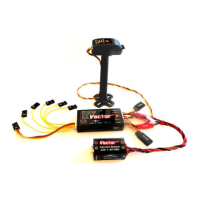
Do you have a question about the Eagle Tree Systems Vector and is the answer not in the manual?
| Brand | Eagle Tree Systems |
|---|---|
| Model | Vector |
| Category | Controller |
| Language | English |
Instructions on reading the manual for safety and understanding features.
Explanation of symbols indicating warnings, tips, and feature applicability.
Important safety guidelines and precautions for using the device and model aircraft.
Overview of the Vector Flight Controller + OSD features and capabilities.
Lists all items included in the product package for user verification.
Details technical specifications like supported airframes, dimensions, and mass.
Information on obtaining customer support and submitting feature requests.
Steps for installing software, downloading updates, and updating firmware.
Definitions of technical terms used throughout the manual for clarity.
Diagram and explanation of the Vector controller's various port connections.
Connecting GPS/Mag, Current Sensor/PSU, and other accessories to the Vector.
Details about the Vector's power supply unit output capabilities and current limits.
Overview of the Vector's wire harnesses and their functions for connecting components.
Strategies for powering video equipment using the Vector's connections.
Connecting the Vector to the RC receiver using the dedicated receiver harness.
Procedures for connecting servos and ESCs to the Vector's output ports.
Connecting receiver RSSI and configuring link quality for SPPM/S.BUS.
Guidelines for mounting the Vector unit, including location, orientation, and technique.
Instructions for mounting the GPS/MAG sensor, considering interference and orientation.
Instructions for mounting the Current Sensor/PSU and optional Pitot Tube.
How to control the Vector using radio switch inputs like Mode and Submode.
High-level steps for configuring the Vector, including radio and software setup.
Steps for configuring the Vector using the dedicated Windows software.
Configuring the Vector using OSD stick menus or the InfoPanel display.
Teaching the Vector serial channel mappings for SPPM/S.BUS receivers.
How to navigate menus and exit menu mode using control sticks.
Choosing and confirming the correct airframe type for configuration.
Wizard to learn radio stick directions, failsafe positions, and RSSI.
Setting up auxiliary inputs and configuring auxiliary servo outputs.
Setting up and configuring flight modes using mode and submode switches.
Steps for configuring and tuning the flight controller and stabilizer.
Procedures and issues related to arming and disarming multirotor motors.
Setting up Return to Home and other safety features.
Configuring the On-Screen Display, including readouts and alarms.
Setting up and calibrating the magnetic compass for navigation.
Setting up and using the Alerter Buzzer/LCD for status indications.
Interactive preflight checklist and resetting the home position.
General recommendations for initial flights, including ground tests and takeoffs.
Procedures for resetting level flight while airborne for multirotors and fixed wings.
Testing and operating the Return to Home feature, including limitations.
Tools for advanced OSD configuration, including readouts, gauges, and alarms.
Connecting and using optional RPM and temperature sensors with the Vector.
Configuring waypoints using software and displaying them on the OSD.
Using the flight data recorder, downloading, viewing, and saving logged data.
Advanced configuration options for RTH, including altitude and speed settings.
Performing calibration for electrical, altimeter, and GPS sensors.
Settings for GPS position display format and fix quality criteria.
Solutions for poor multirotor position holding, bouncing, and motor speed problems.
Adjusting RTH and circling speeds, and troubleshooting flight behavior.
Troubleshooting GPS fix issues and audio/video interference problems.
Addressing unresolved Vector issues, software launch problems, and receiver detection.
Messages related to input detection, configuration errors, and missing sensors.
Errors indicating calibration issues or problems with sensors like compass or GPS.
Messages related to flight modes, arming status, and levelness checks.
Messages indicating failsafe triggers, RTH engagement, and landing events.
Warnings about vibration, power issues, or system status changes.
Descriptions of fundamental numeric readouts like voltage, current, and receiver inputs.
Descriptions of output percentages, Spektrum telemetry, and distance data.
Descriptions of Spektrum fades, receiver link quality, and other telemetry data.